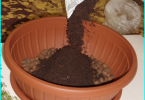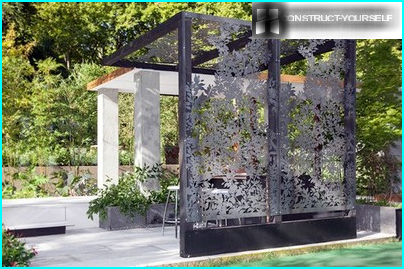
If the country or farmland is located in areas with difficult terrain, while its arrangement is necessary to solve the issue of strengthening of slopes and slopes. Using retaining walls in the landscape, can not only resolve this issue but to decorate the territory of another architectural and planning element. As materials suitable for the construction of retaining walls, use concrete blocks, natural stone, logs, bricks and mesh structures. Artificial structures are sometimes installed on absolutely flat ground to make «flavor» in the design of the site. For the bulk of the fertile land arrange gorgeous flower beds, which on an elevated place look especially unusual and beautiful. To strengthen the effect of elevation in the garden, you can use the landing of specially selected varieties of plants. In addition to planting flowers wall supports may serve as a basis for incorporation of additional elements, which increases functionality of their use.
The contents
This video shows how you can build on a plot of retaining walls with their hands, using bricks or concrete blocks.
Methods of laying stone retaining walls
There are several ways of laying stones. However, in any case, the first row are placed in recesses specially trained in the soil. The stones of subsequent rows spread in a checkerboard pattern, thus providing a reliable two-point support for each of them. To give special strength of retaining walls of stone bonded with cement mortar. Wall that play a largely decorative role, erecting «dry» method:
- Paving stones having the same height, smooth horizontal lines, which are used in the gardens, decorated in a regular style. As a material used Sandstone or gneiss. These rocks stones do not create problems during processing, making it possible to form the desired number of blocks of equal size.
- Laying rectangular stones having different heights, in horizontal rows. This retaining wall looks less strictly. Considered universal, and therefore suitable for decoration of any garden, regardless of the style of landscape design. When selecting material, pay attention to the color of the stone.
- In the estates, rustic, perform retaining wall of rubble stone. Typically, these stones have different sizes, which complicates the process of their stacking. But the designer opens a wide field for imagination when working with such material.
- Popular with professionals and cyclopean masonry of natural stones with a rounded shape. This is ideal for both marine and river pebbles. In the space formed between adjacent stones is filled with soil, and planted the special hardy varieties of flowering plants.
The shape and size of the rocks also determines the kind of future retaining walls.
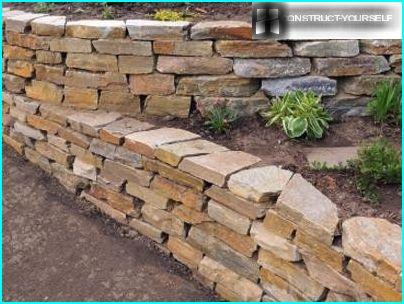
Retaining wall, laid dry method of matched size and color of natural stone is the decoration of the site
View of dry stone walls in the context of:
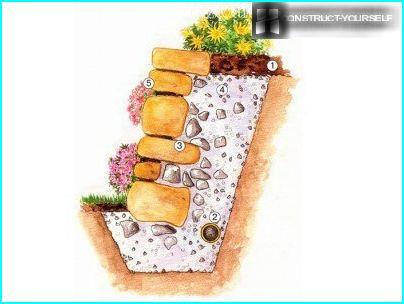
Longitudinal section of stone retaining walls, which are clearly visible the main structural elements of this building. The deviation of the wall from the vertical is 15 degrees
The legend of the diagram:
- The trench, which lays the Foundation that serves as a solid Foundation for the supporting walls. The trench width is 40 cm, if the height of the constructed wall will be equal to one meter.
- The culvert which provides drainage of water. If you do not provide drainage at the base of the wall, then collecting behind it, the water will wash away soil and destroy the building.
- The binding stone are laid with the long side to the depth of the Foundation, provides additional stability of the structure. For the same reason, when laying the stones specifically give the wall a slight slope of not more than 10-15 degrees.
- The layer of rock and rubble which fills the trench. When backfilling stone-and-gravel mixture is thoroughly compacted. Due to this, the wall becomes wider and much more stable.
- The niche formed between the individual stones are filled with earth. Sometimes especially in between the stones leave «socket», then to plant them in a basket (curly) plants. After their expansion, the wall turns into a beautiful decorative element of landscape design.
Please note! For supporting walls, constructed on the sun-exposed areas, suitable bell, thrift, burachok, soapwort. Also grow well in such conditions stonecrop, obrieta, saxifrage, St. John’s wort, Phlox low-growing. You can sit on the sun cross, the young, the song, Veronica, baby’s breath, carnation-the deltoides. For retaining walls that are in shadow, you should choose the Corydalis, saxifrage, cymbalaria, lobularia, walstein, ferns.
How to strengthen the terrace logs?
In some regions it is easier and cheaper for the construction of supporting walls to use logs of the same diameter. Wooden retaining wall landscape design looks no less beautiful than the stone structure.
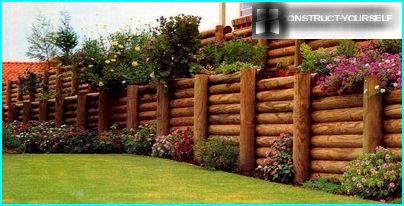
One of the possible methods for the construction of a retaining wall made of round logs of equal diameter to firmly grip the slope from destruction
The logs are impregnated with special solutions hindering the process of decay, and are mounted vertically in a pre-dug trench. That the wall held fast in the ground, bury it a foot. Adjacent logs come close to each other. The construction will be smooth for a long time, if at the bottom of the trench to pour a layer of gravel and compacted it thoroughly. The free space in the trench around the logs is filled with gravel, and then filled with concrete solution.
Here is another example of the arrangement:
Construction of retaining wall of concrete
Concrete retaining walls also dug a shallow trench in which to install the formwork to the desired height. For the effective containment of the concrete mass outside strengthen the formwork props. Before pouring the solution set of a reinforcing frame made of metal rods and wires. Also at the base of the wall stack pipe, through which is discharged water accumulating behind retaining wall.
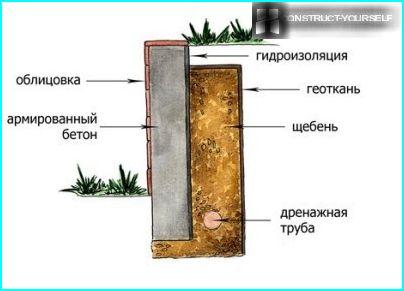
A little secret — in order to ensure the evenness and smoothness of the front surface of the retaining wall, it is necessary to the inner wall of the casing to attach the roofing material
Concrete can be erected quite an impressive construction:
The use of gabions and bricks
Easily erected with his own hands retaining wall of gabions – mesh baskets filled with natural stone. Gabions called volumetric mesh containers manufactured in the factory of metal wire with a protective corrosion-resistant coating.
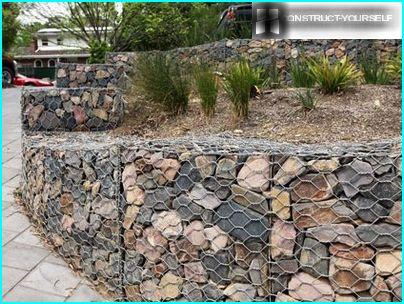
The mesh structures are widely used for the device of retaining walls when terracing of the site. Mesh containers, filled with large stones, can stand for decades
Mesh containers vary in size and shape, which may be:
- box;
- cylindrical;
- mattress-tuface.
For retaining walls more suitable box-shaped gabions. Nets are brought to the site in the folded form. Then manually straightened and filled with stones. While large stones exceeding in diameter the size of the grid cells are placed on the edges of the container. The middle is filled with fine gravel.
Between mesh boxes fasten directly to the site of installation of a retaining wall galvanized binding wire. With the use of sharp pins, easy digged into the ground are mesh boxes are securely fixed in place. To the walls of the mesh bends when laying the filler, carry out their screed with the help of braces. Loaded with stones and rubble container lid, which is attracted specifically designed for this device. Gabion structures have a long service life. With loads gabina structure is deformed, but not destroyed.
Important! The garden retaining wall of gabions can not take care of the drainage outlets, as through the rock litter water passes freely.
Initially retaining walls were built in mountainous areas for strengthening of dangerous slopes, and to arrest soil in the vineyards. Gradually this type of facilities was used in landscaping. In the garden plots you can see the retaining wall of bricks. This affordable building material can be easily installed with the use of the binder solution in a flat wall.
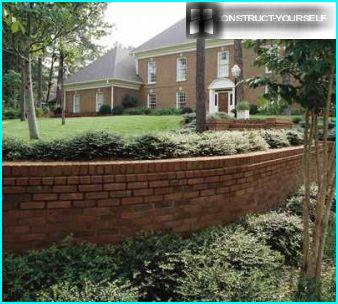
Retaining wall, neatly lined with bricks, using different ways of styling, beautifully framed by the sublime plot
All the methods of the device of retaining walls can test on your site any person. The difficulty of the work lies only in carrying heavy loads, because the stones are rather big weight. Therefore it is better to carry out these works with a few assistants. Of course, the attraction of professionals to the construction of a retaining wall frees people from the search and delivery of necessary materials, as well as from the heavy manual labor, consuming not only time, but also forces.



